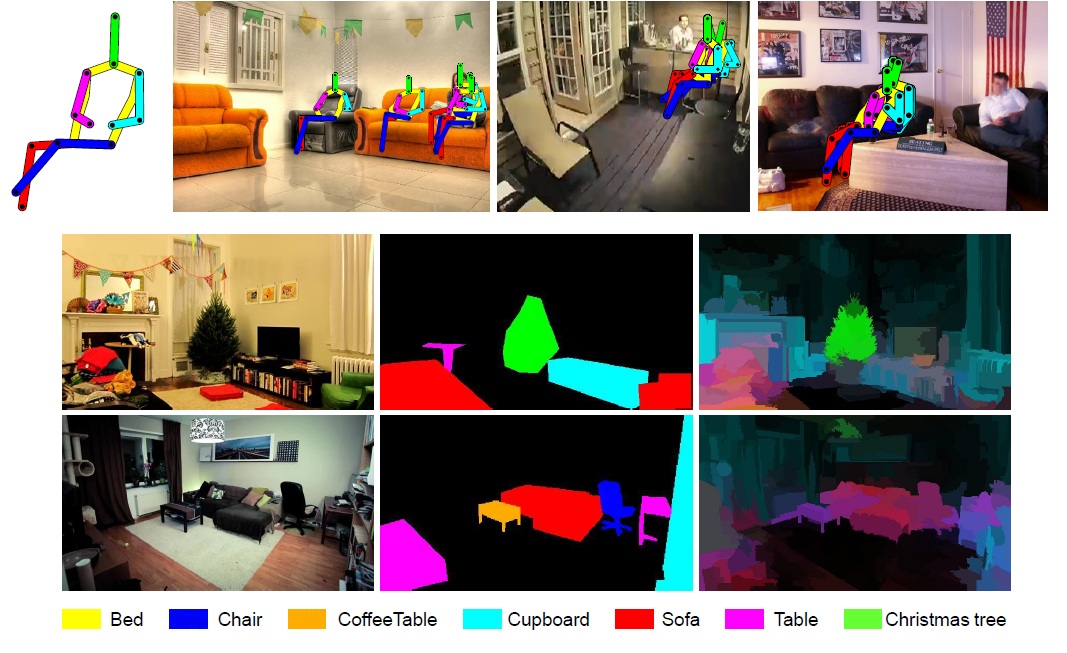Section: New Results
Human activity capture and classification
Scene Semantics from Long-Term Observation of People
Participants : Vincent Delaitre, Ivan Laptev, Josef Sivic, David Fouhey [CMU] , Abhinav Gupta [CMU] , Alexei Efros [CMU] .
Our everyday objects support various tasks and can be used by people for different purposes. While object classification is a widely studied topic in computer vision, recognition of object function, i.e., what people can do with an object and how they do it, is rarely addressed. In this work we construct a functional object description with the aim to recognize objects by the way people interact with them. We describe scene objects (sofas, tables, chairs) by associated human poses and object appearance. Our model is learned discriminatively from automatically estimated body poses in many realistic scenes. In particular, we make use of time-lapse videos from YouTube providing a rich source of common human-object interactions and minimizing the effort of manual object annotation. We show how the models learned from human observations significantly improve object recognition and enable prediction of characteristic human poses in new scenes. Results are shown on a dataset of more than 400,000 frames obtained from 146 time-lapse videos of challenging and realistic indoor scenes. Some of the estimated human poses and results of pixel-wise scene segmentation are shown in Figure 3 .
This work has been published in [10] .
|
Analysis of Crowded Scenes in Video
Participants : Ivan Laptev, Josef Sivic, Mikel Rodriguez [MITRE] .
In this work we first review the recent studies that have begun to address the various challenges associated with the analysis of crowded scenes. Next, we describe our two recent contributions to crowd analysis in video. First, we present a crowd analysis algorithm powered by prior probability distributions over behaviors that are learned on a large database of crowd videos gathered from the Internet. The proposed algorithm performs like state-of-the-art methods for tracking people having common crowd behaviors and outperforms the methods when the tracked individuals behave in an unusual way. Second, we address the problem of detecting and tracking a person in crowded video scenes. We formulate person detection as the optimization of a joint energy function combining crowd density estimation and the localization of individual people. The proposed methods are validated on a challenging video dataset of crowded scenes. Finally, the chapter concludes by describing ongoing and future research directions in crowd analysis.
This work is to appear in [17] .
Actlets: A Novel Local Representation for Human Action Recognition in Video
Participants : Muhammad Muneeb Ullah, Ivan Laptev.
This work addresses the problem of human action recognition in realistic videos. We follow the recently successful local approaches and represent videos by means of local motion descriptors. To overcome the huge variability of human actions in motion and appearance, we propose a supervised approach to learn local motion descriptors – actlets – from a large pool of annotated video data. The main motivation behind our method is to construct action-characteristic representations of body joints undergoing specific motion patterns while learning invariance with respect to changes in camera views, lighting, human clothing, and other factors. We avoid the prohibitive cost of manual supervision and show how to learn actlets automatically from synthetic videos of avatars driven by the motion-capture data. We evaluate our method and show its significant improvement as well as its complementarity to existing techniques on the challenging UCF-sports and YouTube-actions datasets.
This work has been published in [16] .
Layered Segmentation of People in Stereoscopic Movies
Participants : Karteek Alahari, Guillaume Seguin, Josef Sivic, Ivan Laptev.
In this work we seek to obtain a layered pixel-wise segmentation of multiple people in a stereoscopic video. This involves challenges such as dealing with unconstrained stereoscopic video, non-stationary cameras, complex indoor and outdoor dynamic scenes. The contributions of our work are three-fold: First, we develop a layered segmentation model incorporating person detections and pose estimates, as well as colour, motion, and stereo disparity cues. The model also explicitly represents depth ordering and occlusions of people. Second, we introduce a stereoscopic dataset with frames extracted from feature length movies “StreetDance 3D" and “Pina". In addition to realistic stereo image data, it contains nearly 700 annotated poses, 1200 annotated detections, and 400 pixel-wise segmentations of people. Third, we evaluate the benefits of stereo signal for person detection, pose estimation and segmentation in the new dataset. We demonstrate results on challenging realistic indoor and outdoor scenes depicting multiple people with frequent occlusions. Example result is shown in Figure 4 .
This work has been submitted to CVPR 2013.
|
Highly-Efficient Video Features for Action Recognition and Counting
Participants : Vadim Kantorov, Ivan Laptev.
Local video features provide state-of-the-art performance for action recognition. While the accuracy of action recognition has been steadily improved over the recent years, the low speed of feature extraction remains to be a major bottleneck preventing current methods from addressing large-scale applications. In this work we demonstrate that local video features can be computed very efficiently by exploiting motion information readily-available from standard video compression schemes. We show experimentally that the use of sparse motion vectors provided by the video compression improves the speed of existing optical-flow based methods by two orders of magnitude while resulting in limited drops of recognition performance. Building on this representation, we next address the problem of event counting in video and present a method providing accurate counts of human actions and enabling to process 100 years of video on a modest computer cluster.
This work has been submitted to CVPR 2013.




